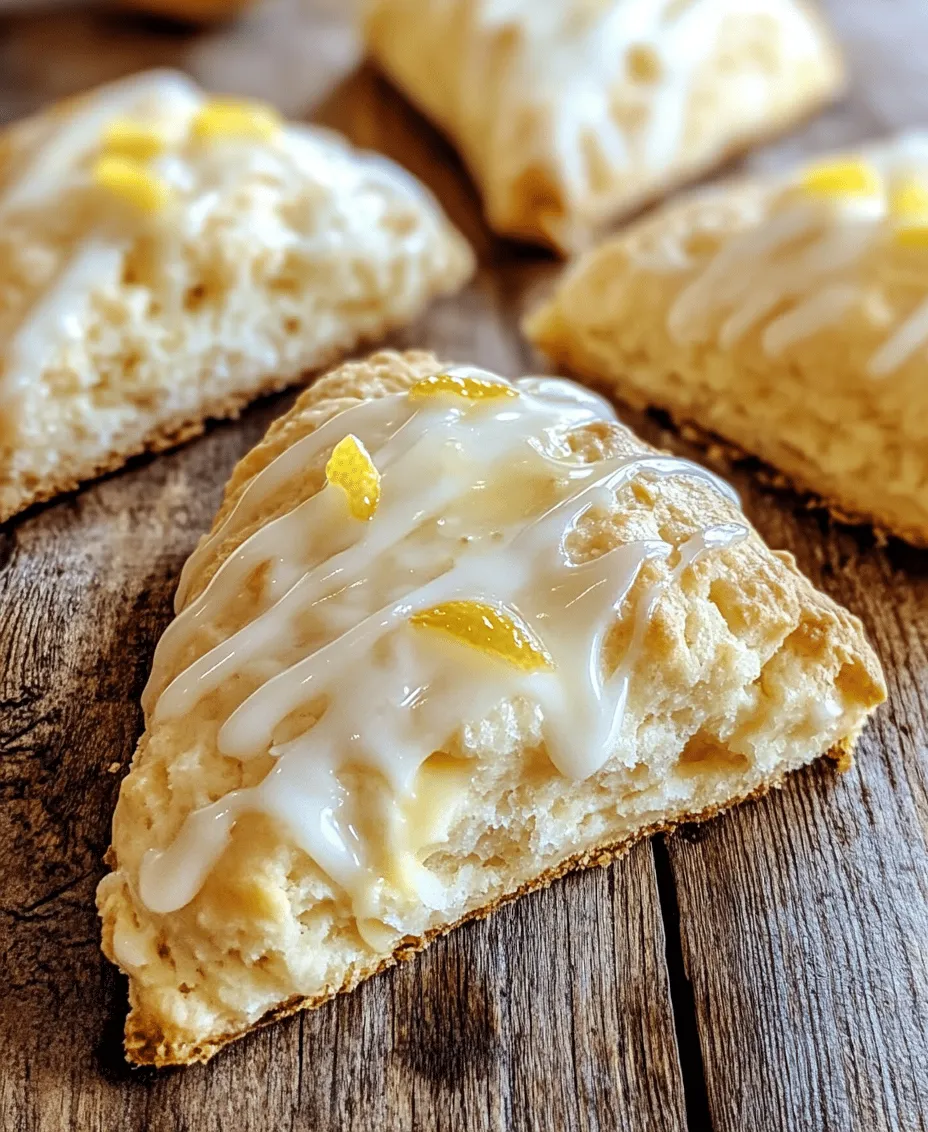Introduction
Scones have long held a cherished place in the realm of baked goods, adored for their crumbly texture and versatility. Whether enjoyed at breakfast, paired with a cup of tea, or served at a festive gathering, scones offer a delightful treat that brings a touch of comfort to any setting. Among the many flavors that can be crafted into this classic pastry, lemon cream scones stand out for their unique combination of zesty brightness and rich, creamy indulgence. The invigorating flavor of lemon, combined with the lusciousness of cream, creates an irresistible baked good that is sure to please.
The best part? This lemon cream scone recipe is straightforward, making it accessible for bakers of all skill levels. Whether you’re preparing for an afternoon tea party or simply craving a comforting snack at home, these scones are the perfect addition to your repertoire.
The Allure of Scones
Scones belong to a family of baked goods known for their flaky texture and rich flavors. Originating from the British Isles, they have been a staple in tea culture since the 19th century. Traditionally served with clotted cream and preserves, scones have evolved over time, leading to a variety of flavors and styles. From classic plain scones to those infused with fruits, nuts, or spices, the versatility of this delightful pastry is truly remarkable.
The cultural significance of scones, especially in British tea traditions, cannot be overstated. They are often associated with leisurely afternoons spent sampling delicate treats while sipping tea. The inclusion of lemon as a flavor in scones is a natural progression, as it complements the sweetness of the pastry while adding a refreshing zing. Lemon cream scones, in particular, embody the best of both worlds—combining the zestiness of lemon with the richness of cream, making them a favorite among many.
Today, scones have transcended their traditional roots, appearing in various forms across the globe. Many bakers experiment with flavors and ingredients, pushing the boundaries of this time-honored recipe. However, the timeless appeal of lemon cream scones remains, captivating taste buds and providing a delightful experience with every bite.
Ingredients Breakdown
Before diving into the process of making lemon cream scones, it’s essential to understand the role each ingredient plays in creating the perfect pastry. Here’s a breakdown of the key ingredients you’ll need for this recipe:
– All-Purpose Flour: The backbone of any scone, all-purpose flour is crucial for providing structure and texture. Its moderate protein content helps achieve that ideal balance between tenderness and flakiness, allowing the scones to rise beautifully in the oven.
– Granulated Sugar: This ingredient serves a dual purpose. While it adds a touch of sweetness to the dough, it also enhances the overall flavor profile of the scones. The sugar will caramelize slightly during baking, giving the scones a beautiful golden hue.
– Baking Powder: As a key leavening agent, baking powder is responsible for helping the scones rise. It creates air pockets in the dough, resulting in a light and fluffy texture. Be sure to use fresh baking powder for the best results.
– Salt: Though it may seem minor, salt plays a crucial role in baking. It enhances the flavors of the other ingredients, balancing the sweetness and elevating the overall taste of the scones.
– Unsalted Butter: The secret to achieving a flaky texture lies in the butter. Cold, unsalted butter is cut into the flour, creating small pockets of fat that result in that coveted flakiness. The butter also contributes richness to the scones, making them more satisfying.
– Heavy Cream: This ingredient adds moisture and richness to the dough, creating a tender crumb. The fat content in heavy cream also enhances the scones’ flavor, making each bite luscious and satisfying.
– Lemon Zest: For a vibrant lemon flavor, lemon zest is the star of the show. It infuses the scone dough with aromatic oils, enhancing the lemony essence without introducing excessive acidity. The zest provides a bright, fresh flavor that pairs beautifully with the creaminess of the scones.
– Vanilla Extract: While lemon takes center stage, a splash of vanilla extract adds depth to the flavor profile. It rounds out the sweetness and complements the lemon, creating a balanced taste experience.
– Powdered Sugar and Lemon Juice: These ingredients are used to create a simple icing that drizzles beautifully over the baked scones. The sweetness of powdered sugar combined with the tartness of lemon juice creates a delightful finish, elevating the overall presentation and flavor.
Step-by-Step Instructions for Making Lemon Cream Scones
Preheat the Oven
The first step in making lemon cream scones is to preheat your oven to 400°F (200°C). This temperature is crucial for achieving the perfect rise and golden-brown crust. Preheating the oven allows for an even baking environment, ensuring that the scones cook thoroughly while developing a lovely texture and color.
While the oven is heating up, you can prepare your baking sheet by lining it with parchment paper. This will prevent the scones from sticking and make cleanup a breeze.
Mixing Dry Ingredients
In a large mixing bowl, combine the all-purpose flour, granulated sugar, baking powder, and salt. Whisk these dry ingredients together until they’re evenly distributed. This step is essential to ensure that the baking powder and salt are evenly mixed throughout the flour, which helps the scones rise uniformly.
– Tip: To avoid clumping and ensure even distribution, consider sifting the flour before combining it with the other dry ingredients. This will aerate the flour and help create a lighter texture in the finished scones.
Once the dry ingredients are well mixed, it’s time to incorporate the cold, unsalted butter. Cut the butter into small cubes and add it to the flour mixture. Using a pastry cutter or your fingertips, work the butter into the dry ingredients until the mixture resembles coarse crumbs, with small pieces of butter still visible.
– Tip: Be careful not to overwork the dough at this stage. The small chunks of butter are essential for achieving that flaky texture, so aim for a mixture that is just combined.
By following these initial steps, you are well on your way to creating delicious lemon cream scones that will undoubtedly impress anyone fortunate enough to enjoy them. In the next section, we will explore how to incorporate the wet ingredients and form the scones, leading you closer to baking up a delightful batch of this zesty treat.

Cutting in the Butter
One of the essential techniques in creating the perfect lemon cream scones is cutting in the butter. This process involves incorporating cold butter into the flour mixture until it resembles coarse crumbs. The significance of this technique cannot be overstated; it is crucial for achieving that light, flaky texture that is characteristic of high-quality scones.
To cut in the butter effectively, you can use a pastry cutter, two forks, or your fingertips. The goal is to break the butter into small pieces, approximately the size of peas. This will create pockets of fat within the dough that will melt during baking, resulting in a tender and airy scone. Remember to work quickly to prevent the butter from warming up, as this could lead to denser scones.
Incorporating Cream and Flavor
Once the butter is properly cut into the flour mixture, it’s time to add the cream and flavoring. In this recipe, heavy cream is the star ingredient that brings richness and moisture to the scones. When adding the cream, pour it in gradually while using a spatula or wooden spoon to gently mix until just combined.
It is imperative to avoid overmixing at this stage. Gentle mixing is key to maintaining the delicate structure of the scone. If the dough becomes too tough, the scones will lose their lightness and become dense. The objective is to create a soft dough that holds together but is still somewhat sticky. If desired, you can add lemon zest or a few drops of lemon extract at this stage to enhance the citrus flavor.
Shaping the Scones
Shaping the scones is another critical step in the process. After the dough has come together, transfer it onto a lightly floured surface. Gently pat the dough into a circle about 1-inch thick. It’s important to handle the dough as little as possible to prevent it from becoming tough.
Once shaped, use a sharp knife or a bench scraper to cut the dough into wedges or circles. For even baking and a professional appearance, it is best to cut the scones into uniform sizes. If you prefer a more traditional look, you can use a round biscuit cutter to create circular scones. After cutting, place the scones on a baking sheet lined with parchment paper, ensuring they are spaced apart to allow for expansion while baking.
Baking Process
Baking the scones is where the magic truly happens. Preheat your oven to 400°F (200°C) to ensure a hot environment that promotes a good rise. When placing the scones in the oven, keep a close eye on them. The signs of perfectly baked scones include a lightly golden-brown top and a firm, yet tender, crumb when you break one open.
Generally, the baking time will range from 15 to 20 minutes. To ensure they are cooked through, you can insert a toothpick into the center of a scone; if it comes out clean, they are ready. Once baked, allow the scones to cool on a wire rack. This step is vital, as it prevents the bottoms from becoming soggy and allows for proper texture development.
Preparing the Icing
While the scones are cooling, you can prepare the icing. A simple glaze made from powdered sugar and lemon juice will provide a delightful tangy sweetness that perfectly complements the lemon cream scones. To achieve the right consistency for drizzling, start with about a cup of powdered sugar and add lemon juice gradually until you reach a pourable texture.
If you prefer a thicker icing, reduce the amount of lemon juice; for a thinner glaze, add more. Once the scones have cooled completely, drizzle the icing over them using a spoon or a piping bag for a more controlled application. This finishing touch not only adds flavor but also enhances the visual appeal of your scones.
Cooling and Serving
Cooling the scones on a wire rack is crucial for maintaining their texture. Allow them to cool for at least 10 minutes before serving. This will help the glaze set and ensure that the scones retain their light, airy structure.
When it comes to serving, lemon cream scones can be enjoyed on their own or with a variety of accompaniments. A dollop of clotted cream or a spread of butter pairs beautifully with the bright citrus flavor. Additionally, a side of fresh fruit or a berry compote can add a refreshing touch. These scones are perfect for brunch, afternoon tea, or as a delightful snack any time of day.
Variations and Customizations
One of the wonderful aspects of lemon cream scones is their versatility. You can easily customize this recipe to suit your taste preferences or the season. For a delightful twist, consider adding fresh blueberries or raspberries to the dough for a fruity variation. The tartness of the berries complements the lemon beautifully.
Another option is to incorporate poppy seeds into the mix, which not only adds a unique flavor but also creates a visually appealing texture. If you want to experiment with herbs, try adding a teaspoon of finely chopped fresh rosemary or thyme for a savory twist.
For those looking to switch up the icing, consider using cream cheese frosting for a richer topping, or serve the scones with a warm berry compote for a more indulgent treat. You can also adapt the recipe for different occasions: replace the lemon with orange for a festive twist during the winter holidays or infuse chai spices for a cozy tea party.
Nutritional Information
The ingredients in lemon cream scones offer some nutritional benefits. For instance, the use of heavy cream provides a source of calcium and vitamins A and D, while whole wheat flour can add fiber to the recipe. Scones can fit into a balanced diet when enjoyed in moderation.
When considering portion sizes, a typical serving size is one scone, which can be paired with a cup of tea or coffee. Enjoying scones as part of a balanced breakfast or brunch can be both satisfying and delightful, especially when complemented with fresh fruit or yogurt.
Serving Suggestions
Lemon cream scones are incredibly versatile and can be paired with various beverages. A cup of freshly brewed tea is the classic choice, particularly English breakfast or Earl Grey, both of which enhance the citrus flavor. For coffee lovers, a light roast or cold brew can provide a refreshing contrast.
These scones are also an excellent addition to gatherings or special occasions. They can elevate any brunch spread, serve as a delightful treat for afternoon tea, or be presented at a baby shower or bridal brunch. Their bright flavor and beautiful presentation make them a crowd-pleaser that will impress your guests.
Conclusion
Making and enjoying lemon cream scones is a delightful experience that brings warmth and comfort to any occasion. The process of creating these tender, flaky treats is rewarding, resulting in scones that are bursting with bright lemon flavor and a delectable icing finish.
Whether you enjoy them as part of a leisurely brunch, at an afternoon tea gathering, or simply as a snack with your favorite beverage, these scones are sure to please. We encourage you to try this recipe and share it with friends and family, creating cherished memories over a warm and inviting treat. Your kitchen will be filled with delightful aromas, and soon, you’ll be known for your exceptional lemon cream scones.

